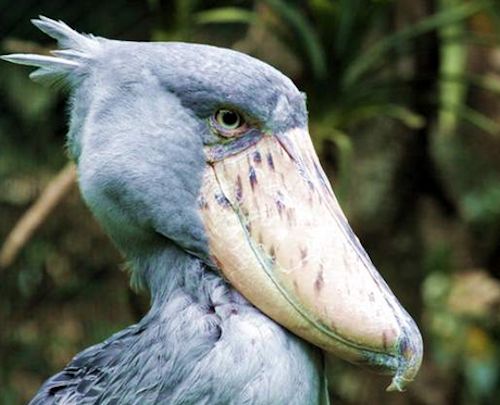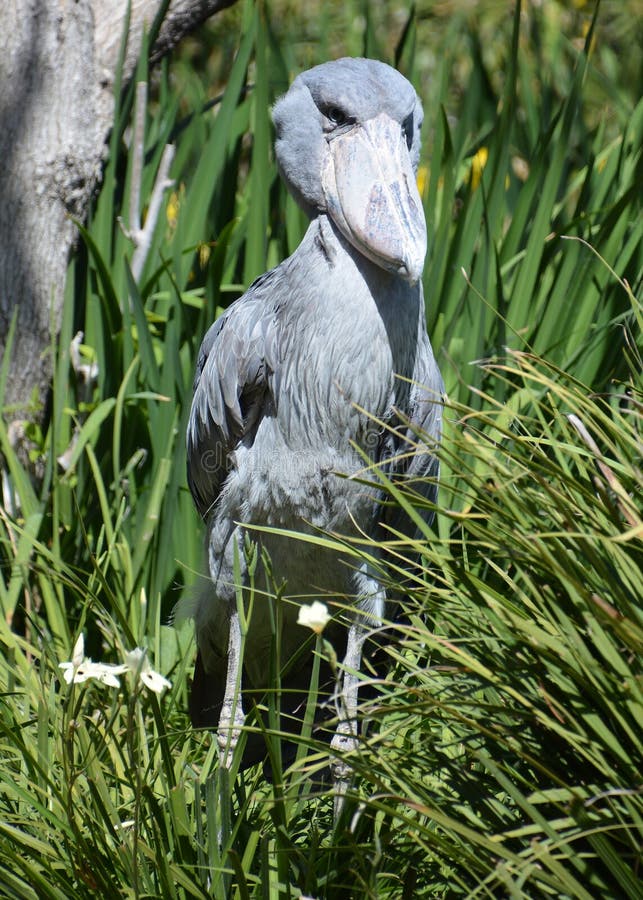

Shoebills have a few other nicknames, including the whalebill and the whale-headed stork. That’s the same as a saltwater crocodile, and more than 3x as strong as a lion, hyena, or tiger’s 1,000 PSI bite. Their bite power is measured at 3,700 PSI (pound per square inch). Shoebill Storks can use their beak to bite the heads of giant lungfish, which are up to six feet long! Even many humans avoid hunting and killing Shoebill Storks as tradition states that it’s bad luck to kill one. One of the reasons for its long lifespan is that it has no natural predators. In both captivity and the wild, they tend to live between 35 and 36 years. Shoebill storks have a very long lifespan!
African shoebill storks full#
It takes the chicks 125 days to reach full independence How Long Do Shoebill Storks Live? They are highly territorial during the breeding season and only lay between one and three eggs every year. They live right on the water, building their nests atop floating aquatic vegetation. Specifically, they inhabit swampy lands from South Sudan to Zambia. Shoebill storks live in tropical East Africa. They don’t usually migrate unless there is a shortage of food in their habitat. They do! Shoebills can fly quite well, and they are especially good at soaring through the sky. They have intimidating expressions on their faces, too! Sometimes it looks like a Shoebill stork is staring right at you, just daring you to say something! Do Shoebills Fly? It uses these big feet to stand confidently on aquatic plants while searching for food. These birds also have long legs and huge feet. The top of the bill ends with a sharp point, like a nail.


Shoebill Stork bills are pale yellow and gray. However, it has a larger circumference than any other type of bird that is currently alive. It is actually the third-longest bill of all birds that are currently living on the globe, following only the pelican and large storks. The most striking feature of the Shoebill stork is its giant bill. They are grey in adulthood but brown as juveniles. They are likely related to herons and pelicans. Measured from tail to beak, they are up to 55 inches long, and they have a wingspan between 7’7” and 8’6”. This beast of a bird can grow to about 5 feet tall, although they are usually between 43 and 55 inches tall. There is no confusing the Shoebill stork with any other birds. Imagine my delight when I discovered that the Shoebill stork is a real and fascinating bird. Was this a real bird, or was it a Photoshopped hoax?! For real.The first time I saw a picture of a Shoebill stork, I wasn’t even sure if it was real. They don't say much, in fact they're mute most of the time, but when they clatter their bills upon running into another shoebill, or if it's mating season, duck for cover: It sounds just like a machine gun. Fierce in the wild, the dauntless shoebill has been known to fight Nile crocodiles to get to their delicious babies, and to fraternize with hippos whenever possible, as the sheer enormity of hippos forces yummy shoebill snacks to the water's surface. Stoic loners – there are only about 3,300 to 5,300 individuals left in the wild – the shoebill stays mainly in its own bailiwick, flying (a mere 150 flaps per minute) anywhere from 500 to 1,000 feet (152 to 305 meters) at a time, with most flights in the 65-foot (20-meter) range. While the momma shoebill will lay two or three eggs, only one chick will survive, as the eldest offspring has a Darwinian dark side and, alas, kills its siblings. Both partners participate in building their nest, which is a kind of floating barge that can be as large as 10 feet wide (3 meters) and 9 feet (almost 3 meters) deep. Weighing anywhere from 12 to 15 pounds and standing up to 5 feet (1.5 meters) tall with a wingspan that can reach 8 feet (over 2 meters), this steely-eyed, aloof and gawky bird hangs out in reedy wetlands where it can nosh on its favorite foods, namely lungfish, tilapia, catfish, frogs, snakes, monitor lizards and baby crocodiles – all of which it can snatch and swallow whole or tear through and decapitate easily with its badass, hollow, pelican-like 7-inch (18-centimeter) beak.Ī monogamous bird that can live up to 35 years, the shoebill finds its mate at a young age and aggressively defends its partner against rivals.


 0 kommentar(er)
0 kommentar(er)
